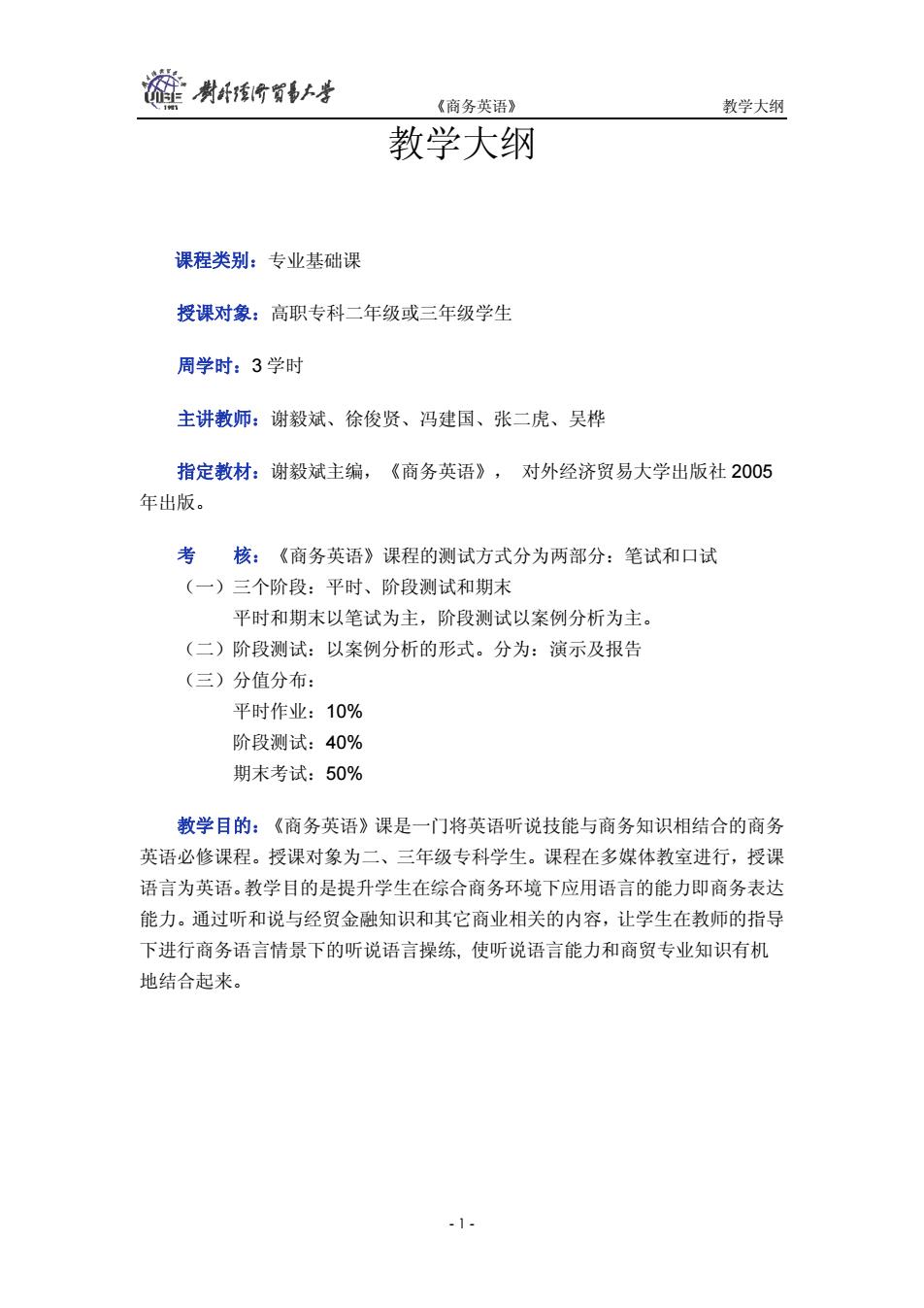
旌肉新女士 《商务英语》 教学大纲 教学大纲 课程类别:专业基础课 授课对象:高职专科二年级或三年级学生 周学时:3学时 主讲教师:谢毅斌、徐俊贤、冯建国、张二虎、吴桦 指定教材:谢毅斌主编,《商务英语》,对外经济贸易大学出版社2005 年出版。 考核:《商务英语》课程的测试方式分为两部分:笔试和口试 (一)三个阶段:平时、阶段测试和期末 平时和期末以笔试为主,阶段测试以案例分析为主。 (二)阶段测试:以案例分析的形式。分为:演示及报告 (三)分值分布: 平时作业:10% 阶段测试:40% 期末考试:50% 教学目的:《商务英语》课是一门将英语听说技能与商务知识相结合的商务 英语必修课程。授课对象为二、三年级专科学生。课程在多媒体教室进行,授课 语言为英语。教学目的是提升学生在综合商务环境下应用语言的能力即商务表达 能力。通过听和说与经贸金融知识和其它商业相关的内容,让学生在教师的指导 下进行商务语言情景下的听说语言操练,使听说语言能力和商贸专业知识有机 地结合起来。 -1-
《商务英语》 教学大纲 - 1 - 教学大纲 课程类别:专业基础课 授课对象:高职专科二年级或三年级学生 周学时:3 学时 主讲教师:谢毅斌、徐俊贤、冯建国、张二虎、吴桦 指定教材:谢毅斌主编,《商务英语》, 对外经济贸易大学出版社 2005 年出版。 考 核:《商务英语》课程的测试方式分为两部分:笔试和口试 (一)三个阶段:平时、阶段测试和期末 平时和期末以笔试为主,阶段测试以案例分析为主。 (二)阶段测试:以案例分析的形式。分为:演示及报告 (三)分值分布: 平时作业:10% 阶段测试:40% 期末考试:50% 教学目的:《商务英语》课是一门将英语听说技能与商务知识相结合的商务 英语必修课程。授课对象为二、三年级专科学生。课程在多媒体教室进行,授课 语言为英语。教学目的是提升学生在综合商务环境下应用语言的能力即商务表达 能力。通过听和说与经贸金融知识和其它商业相关的内容,让学生在教师的指导 下进行商务语言情景下的听说语言操练, 使听说语言能力和商贸专业知识有机 地结合起来
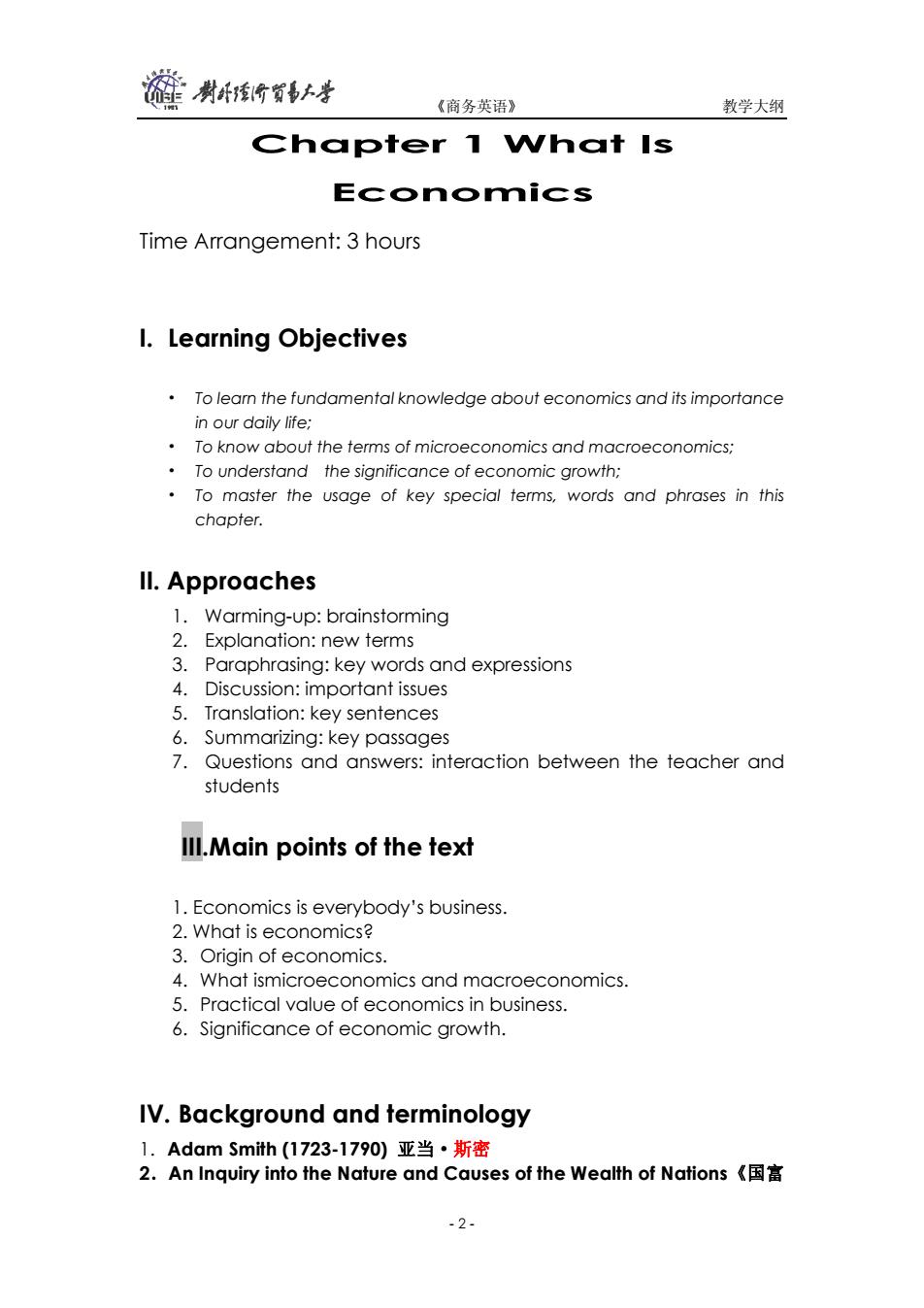
莲剥有首影上号 《商务英语》 教学大纲 Chapter 1 What Is Economics Time Arrangement:3 hours I.Learning Objectives To learn the fundamental knowledge about economics and its importance in our daily life; To know about the terms of microeconomics and macroeconomics; To understand the significance of economic growth; To master the usage of key special terms,words and phrases in this chapter. Il.Approaches 1.Warming-up:brainstorming 2.Explanation:new terms 3.Paraphrasing:key words and expressions 4.Discussion:important issues 5.Translation:key sentences 6.Summarizing:key passages 7.Questions and answers:interaction between the teacher and students Ill.Main points of the text 1.Economics is everybody's business. 2.What is economics? 3.Origin of economics. 4.What ismicroeconomics and macroeconomics. 5.Practical value of economics in business. 6.Significance of economic growth. IV.Background and terminology 1.Adam Smith(1723-1790)亚当·斯密 2.An Inquiry into the Nature and Causes of the Wealth of Nations《国富 -2-
《商务英语》 教学大纲 - 2 - Chapter 1 What Is Economics Time Arrangement: 3 hours I. Learning Objectives • To learn the fundamental knowledge about economics and its importance in our daily life; • To know about the terms of microeconomics and macroeconomics; • To understand the significance of economic growth; • To master the usage of key special terms, words and phrases in this chapter. II. Approaches 1. Warming-up: brainstorming 2. Explanation: new terms 3. Paraphrasing: key words and expressions 4. Discussion: important issues 5. Translation: key sentences 6. Summarizing: key passages 7. Questions and answers: interaction between the teacher and students III.Main points of the text 1. Economics is everybody’s business. 2. What is economics? 3. Origin of economics. 4. What ismicroeconomics and macroeconomics. 5. Practical value of economics in business. 6. Significance of economic growth. IV. Background and terminology 1. Adam Smith (1723-1790) 亚当·斯密 2.An Inquiry into the Nature and Causes of the Wealth of Nations《国富
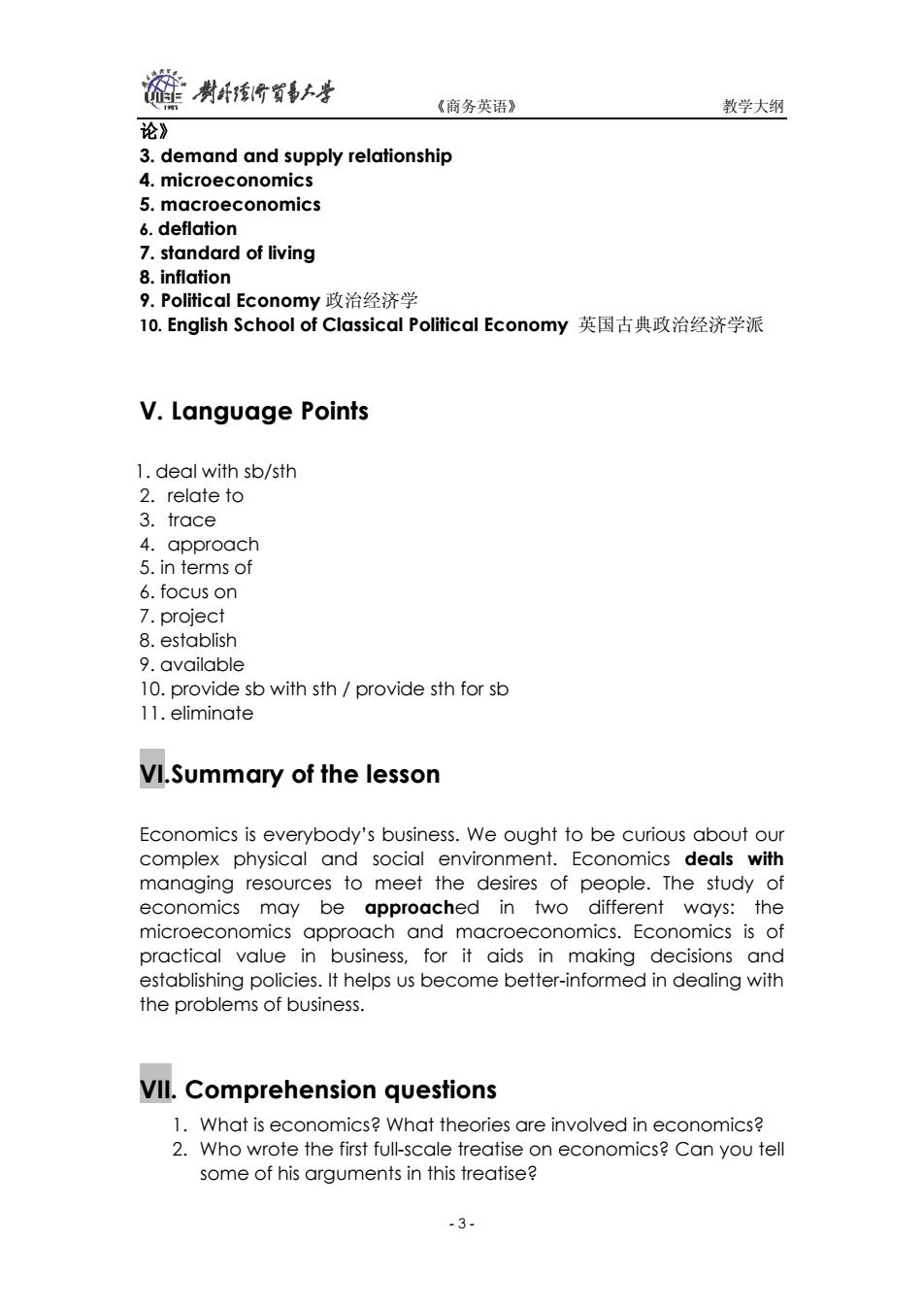
裤两乐新窗子 《商务英语》 教学大纲 论》 3.demand and supply relationship 4.microeconomics 5.macroeconomics 6.deflation 7.standard of living 8.inflation 9.Political Economy政治经济学 Io.English School of Classical Political Economy英国古典政治经济学派 V.Language Points 1.deal with sb/sth 2.relate to 3.trace 4.approach 5.in terms of 6.focus on 7.project 8.establish 9.available 10.provide sb with sth/provide sth for sb 11.eliminate VI.Summary of the lesson Economics is everybody's business.We ought to be curious about our complex physical and social environment.Economics deals with managing resources to meet the desires of people.The study of economics may be approached in two different ways:the microeconomics approach and macroeconomics.Economics is of practical value in business,for it aids in making decisions and establishing policies.It helps us become better-informed in dealing with the problems of business. VIl.Comprehension questions 1.What is economics?What theories are involved in economics? 2.Who wrote the first full-scale treatise on economics?Can you tell some of his arguments in this treatise? 3
《商务英语》 教学大纲 - 3 - 论》 3. demand and supply relationship 4. microeconomics 5. macroeconomics 6. deflation 7. standard of living 8. inflation 9. Political Economy 政治经济学 10. English School of Classical Political Economy 英国古典政治经济学派 V. Language Points 1. deal with sb/sth 2. relate to 3. trace 4. approach 5. in terms of 6. focus on 7. project 8. establish 9. available 10. provide sb with sth / provide sth for sb 11. eliminate VI.Summary of the lesson Economics is everybody’s business. We ought to be curious about our complex physical and social environment. Economics deals with managing resources to meet the desires of people. The study of economics may be approached in two different ways: the microeconomics approach and macroeconomics. Economics is of practical value in business, for it aids in making decisions and establishing policies. It helps us become better-informed in dealing with the problems of business. VII. Comprehension questions 1. What is economics? What theories are involved in economics? 2. Who wrote the first full-scale treatise on economics? Can you tell some of his arguments in this treatise?
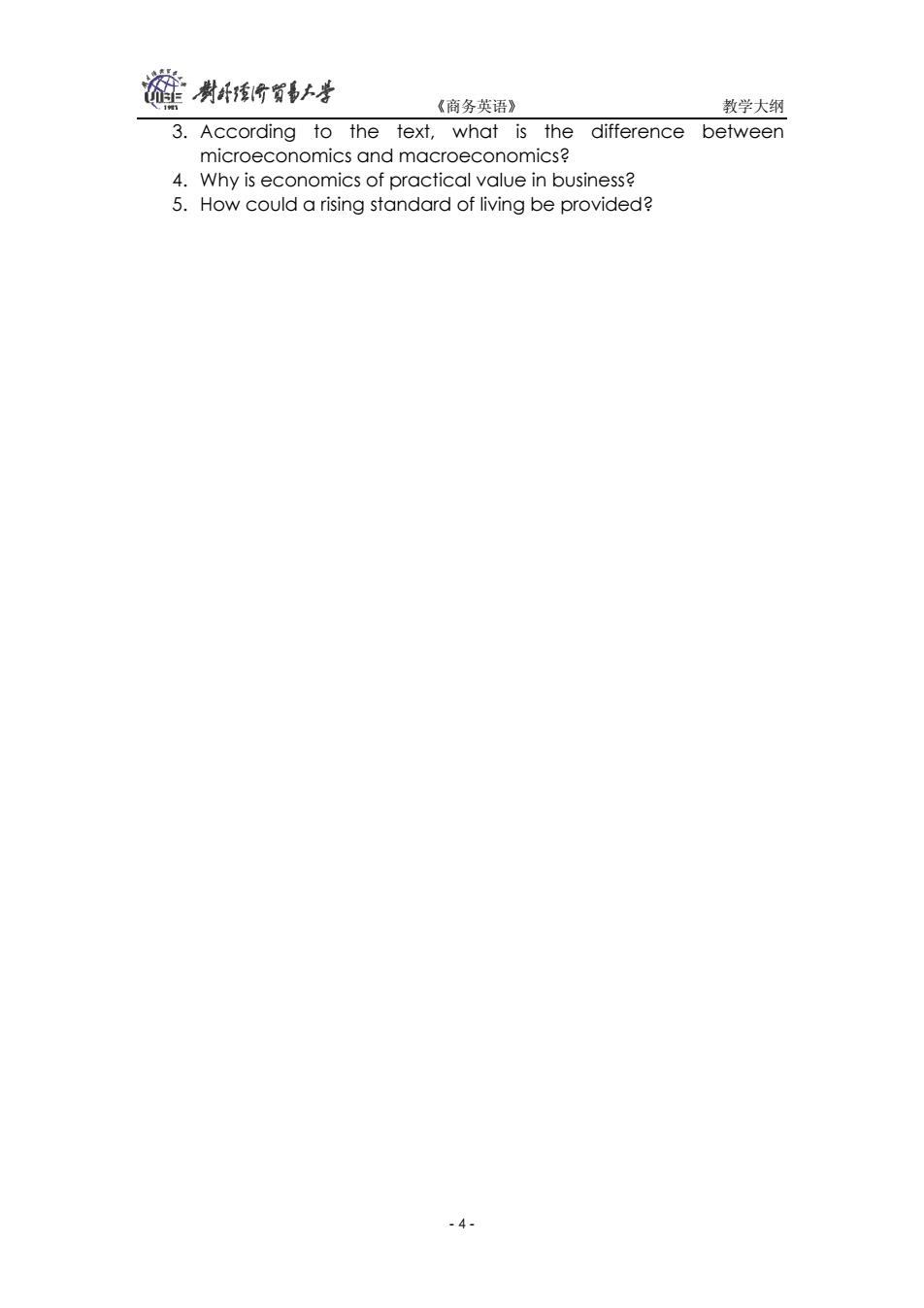
莲尉仟预有省影上号 《商务英语》 教学大纲 3.According to the text,what is the difference between microeconomics and macroeconomics? 4.Why is economics of practical value in business? 5.How could a rising standard of living be provided? -4-
《商务英语》 教学大纲 - 4 - 3. According to the text, what is the difference between microeconomics and macroeconomics? 4. Why is economics of practical value in business? 5. How could a rising standard of living be provided?
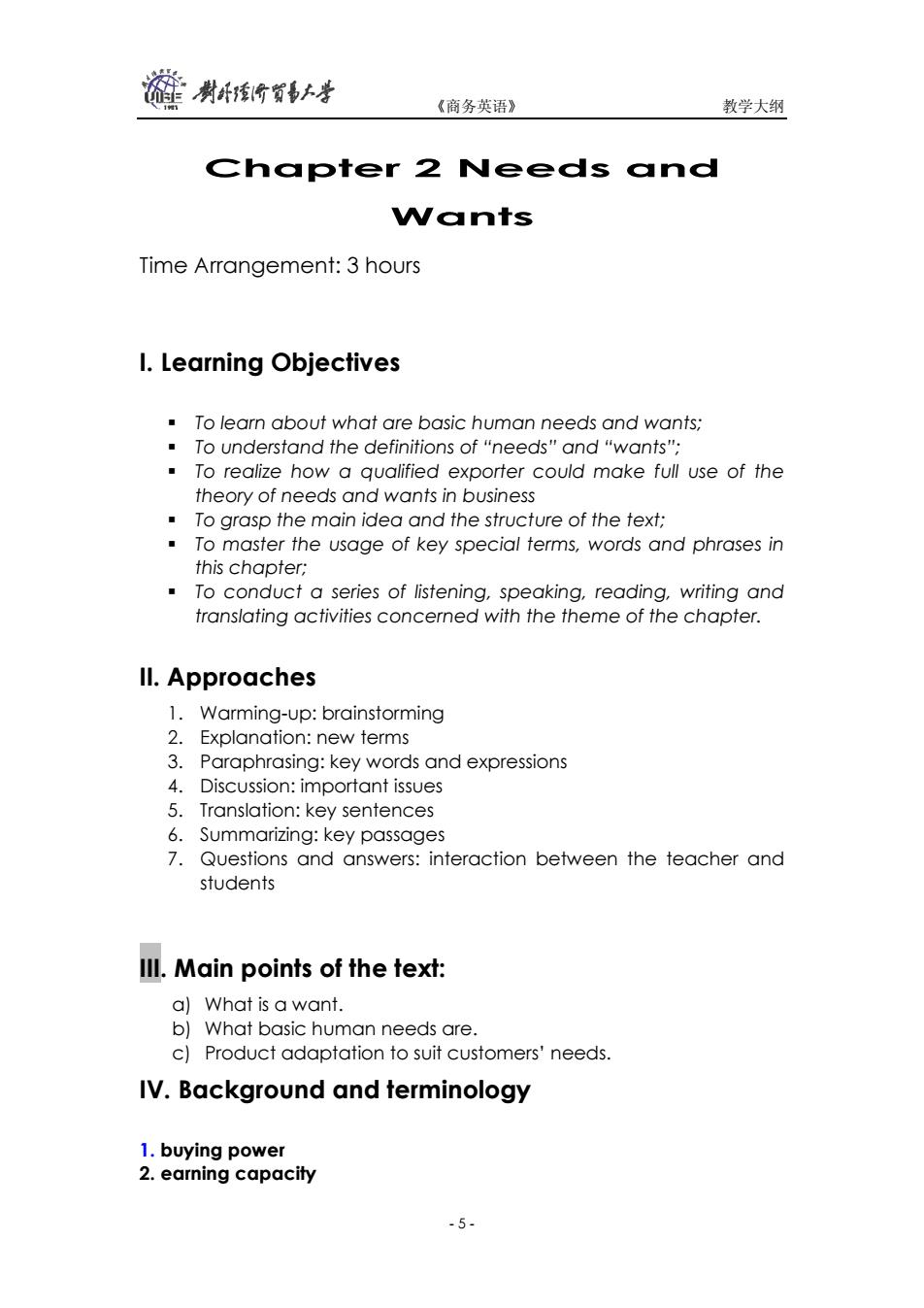
旌黄有寸 《商务英语》 教学大纲 Chapter 2 Needs and Wants Time Arrangement:3 hours I.Learning Objectives To learn about what are basic human needs and wants; ·To understand the definitions of“needs'"and“wants": To realize how a qualified exporter could make full use of the theory of needs and wants in business To grasp the main idea and the structure of the text; To master the usage of key special terms,words and phrases in this chapter; To conduct a series of listening,speaking,reading,writing and translating activities concerned with the theme of the chapter. ll.Approaches 1.Warming-up:brainstorming 2.Explanation:new terms 3.Paraphrasing:key words and expressions 4.Discussion:important issues 5.Translation:key sentences 6. Summarizing:key passages 7. Questions and answers:interaction between the teacher and students Ill.Main points of the text: a)What is a want. b)What basic human needs are. c)Product adaptation to suit customers'needs. IV.Background and terminology 1.buying power 2.earning capacity -5-
《商务英语》 教学大纲 - 5 - Chapter 2 Needs and Wants Time Arrangement: 3 hours I. Learning Objectives To learn about what are basic human needs and wants; To understand the definitions of “needs” and “wants”; To realize how a qualified exporter could make full use of the theory of needs and wants in business To grasp the main idea and the structure of the text; To master the usage of key special terms, words and phrases in this chapter; To conduct a series of listening, speaking, reading, writing and translating activities concerned with the theme of the chapter. II. Approaches 1. Warming-up: brainstorming 2. Explanation: new terms 3. Paraphrasing: key words and expressions 4. Discussion: important issues 5. Translation: key sentences 6. Summarizing: key passages 7. Questions and answers: interaction between the teacher and students III. Main points of the text: a) What is a want. b) What basic human needs are. c) Product adaptation to suit customers’ needs. IV. Background and terminology 1. buying power 2. earning capacity
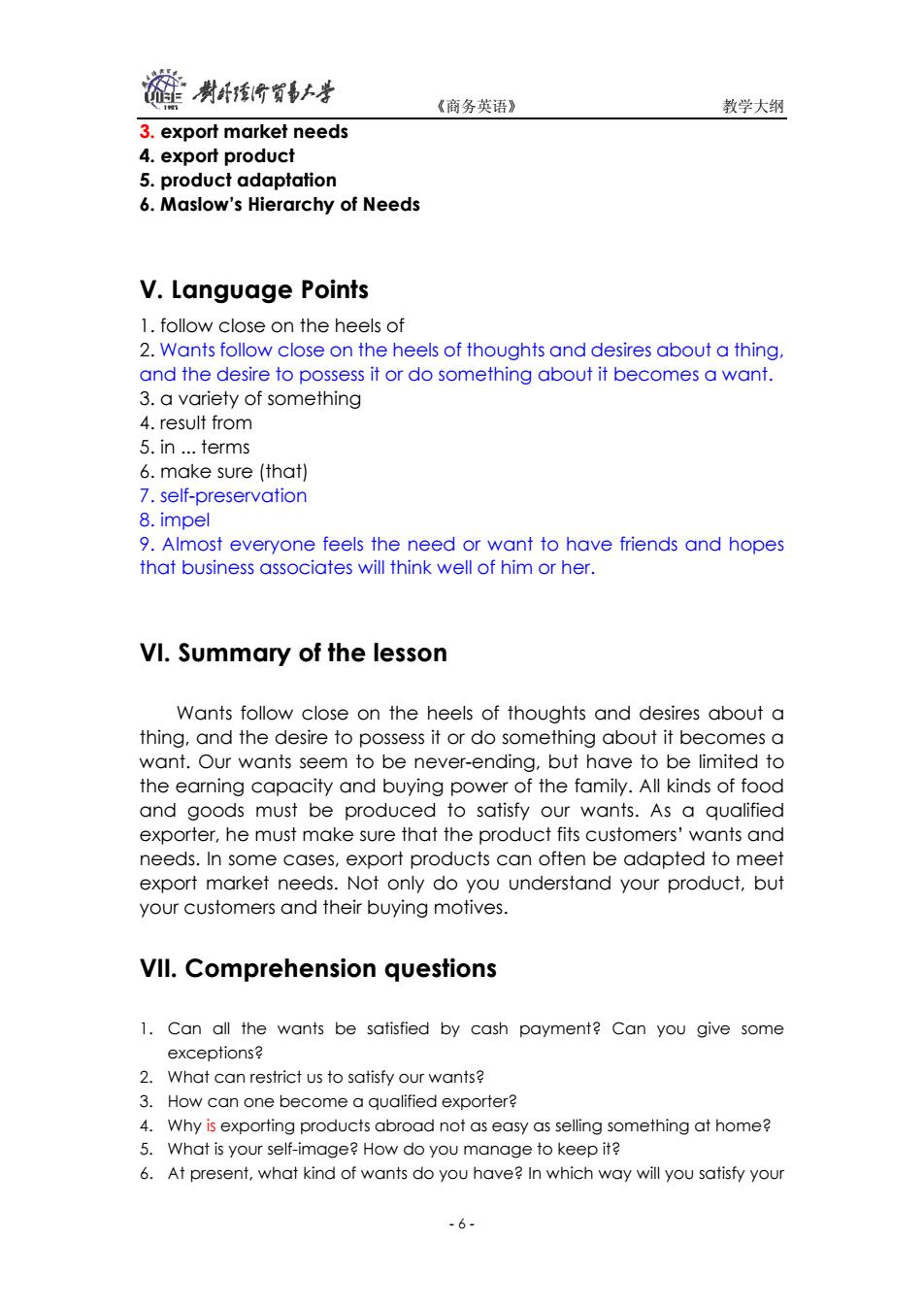
旌黄有寸 《商务英语》 教学大纲 3.export market needs 4.export product 5.product adaptation 6.Maslow's Hierarchy of Needs V.Language Points 1.follow close on the heels of 2.Wants follow close on the heels of thoughts and desires about a thing, and the desire to possess it or do something about it becomes a want. 3.a variety of something 4.result from 5.in...terms 6.make sure (that) 7.self-preservation 8.impel 9.Almost everyone feels the need or want to have friends and hopes that business associates will think well of him or her. VI.Summary of the lesson Wants follow close on the heels of thoughts and desires about a thing,and the desire to possess it or do something about it becomes a want.Our wants seem to be never-ending,but have to be limited to the earning capacity and buying power of the family.All kinds of food and goods must be produced to satisfy our wants.As a qualified exporter,he must make sure that the product fits customers'wants and needs.In some cases,export products can often be adapted to meet export market needs.Not only do you understand your product,but your customers and their buying motives. VIl.Comprehension questions 1.Can all the wants be satisfied by cash payment?Can you give some exceptions? 2.What can restrict us to satisfy our wants? 3.How can one become a qualified exporter? 4.Why is exporting products abroad not as easy as selling something at home? 5.What is your self-image?How do you manage to keep it? 6.At present,what kind of wants do you have?In which way will you satisfy your -6-
《商务英语》 教学大纲 - 6 - 3. export market needs 4. export product 5. product adaptation 6. Maslow’s Hierarchy of Needs V. Language Points 1. follow close on the heels of 2. Wants follow close on the heels of thoughts and desires about a thing, and the desire to possess it or do something about it becomes a want. 3. a variety of something 4. result from 5. in ... terms 6. make sure (that) 7. self-preservation 8. impel 9. Almost everyone feels the need or want to have friends and hopes that business associates will think well of him or her. VI. Summary of the lesson Wants follow close on the heels of thoughts and desires about a thing, and the desire to possess it or do something about it becomes a want. Our wants seem to be never-ending, but have to be limited to the earning capacity and buying power of the family. All kinds of food and goods must be produced to satisfy our wants. As a qualified exporter, he must make sure that the product fits customers’ wants and needs. In some cases, export products can often be adapted to meet export market needs. Not only do you understand your product, but your customers and their buying motives. VII. Comprehension questions 1. Can all the wants be satisfied by cash payment? Can you give some exceptions? 2. What can restrict us to satisfy our wants? 3. How can one become a qualified exporter? 4. Why is exporting products abroad not as easy as selling something at home? 5. What is your self-image? How do you manage to keep it? 6. At present, what kind of wants do you have? In which way will you satisfy your

旌满纤有贺子 《商务英语》 教学大纲 wants? -7-
《商务英语》 教学大纲 - 7 - wants?
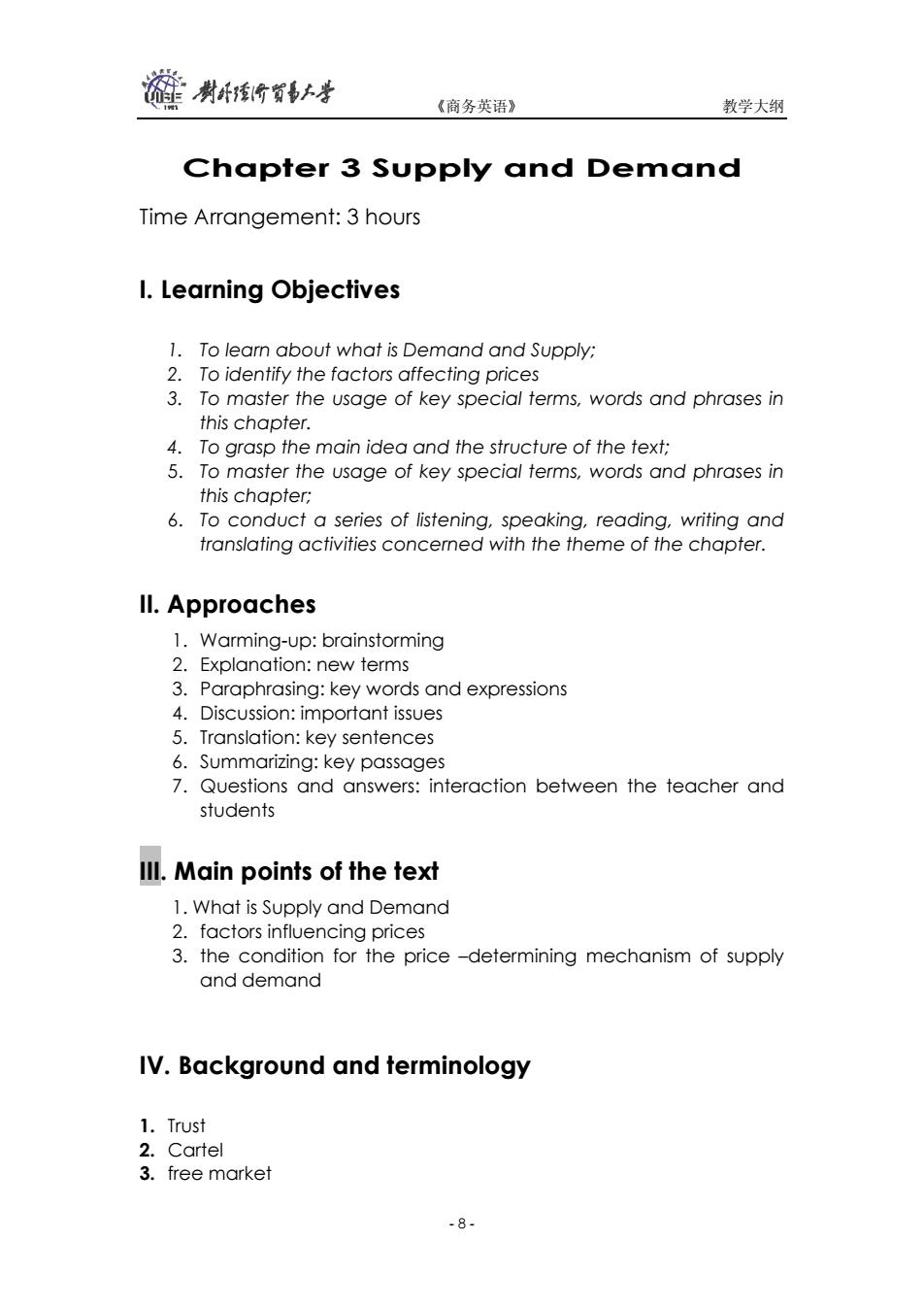
莲尉仟预有省影上号 《商务英语》 教学大纲 Chapter 3 Supply and Demand Time Arrangement:3 hours I.Learning Objectives 1.To learn about what is Demand and Supply; 2.To identify the factors affecting prices 3.To master the usage of key special terms,words and phrases in this chapter. 4.To grasp the main idea and the structure of the text; 5.To master the usage of key special terms,words and phrases in this chapter; 6.To conduct a series of listening,speaking,reading,writing and translating activities concerned with the theme of the chapter. Il.Approaches 1.Warming-up:brainstorming 2.Explanation:new terms 3.Paraphrasing:key words and expressions 4.Discussion:important issues 5.Translation:key sentences 6.Summarizing:key passages 7.Questions and answers:interaction between the teacher and students Ill.Main points of the text 1.What is Supply and Demand 2.factors influencing prices 3.the condition for the price -determining mechanism of supply and demand IV.Background and terminology 1.Trust 2.Cartel 3.free market -8-
《商务英语》 教学大纲 - 8 - Chapter 3 Supply and Demand Time Arrangement: 3 hours I. Learning Objectives 1. To learn about what is Demand and Supply; 2. To identify the factors affecting prices 3. To master the usage of key special terms, words and phrases in this chapter. 4. To grasp the main idea and the structure of the text; 5. To master the usage of key special terms, words and phrases in this chapter; 6. To conduct a series of listening, speaking, reading, writing and translating activities concerned with the theme of the chapter. II. Approaches 1. Warming-up: brainstorming 2. Explanation: new terms 3. Paraphrasing: key words and expressions 4. Discussion: important issues 5. Translation: key sentences 6. Summarizing: key passages 7. Questions and answers: interaction between the teacher and students III. Main points of the text 1. What is Supply and Demand 2. factors influencing prices 3. the condition for the price –determining mechanism of supply and demand IV. Background and terminology 1. Trust 2. Cartel 3. free market
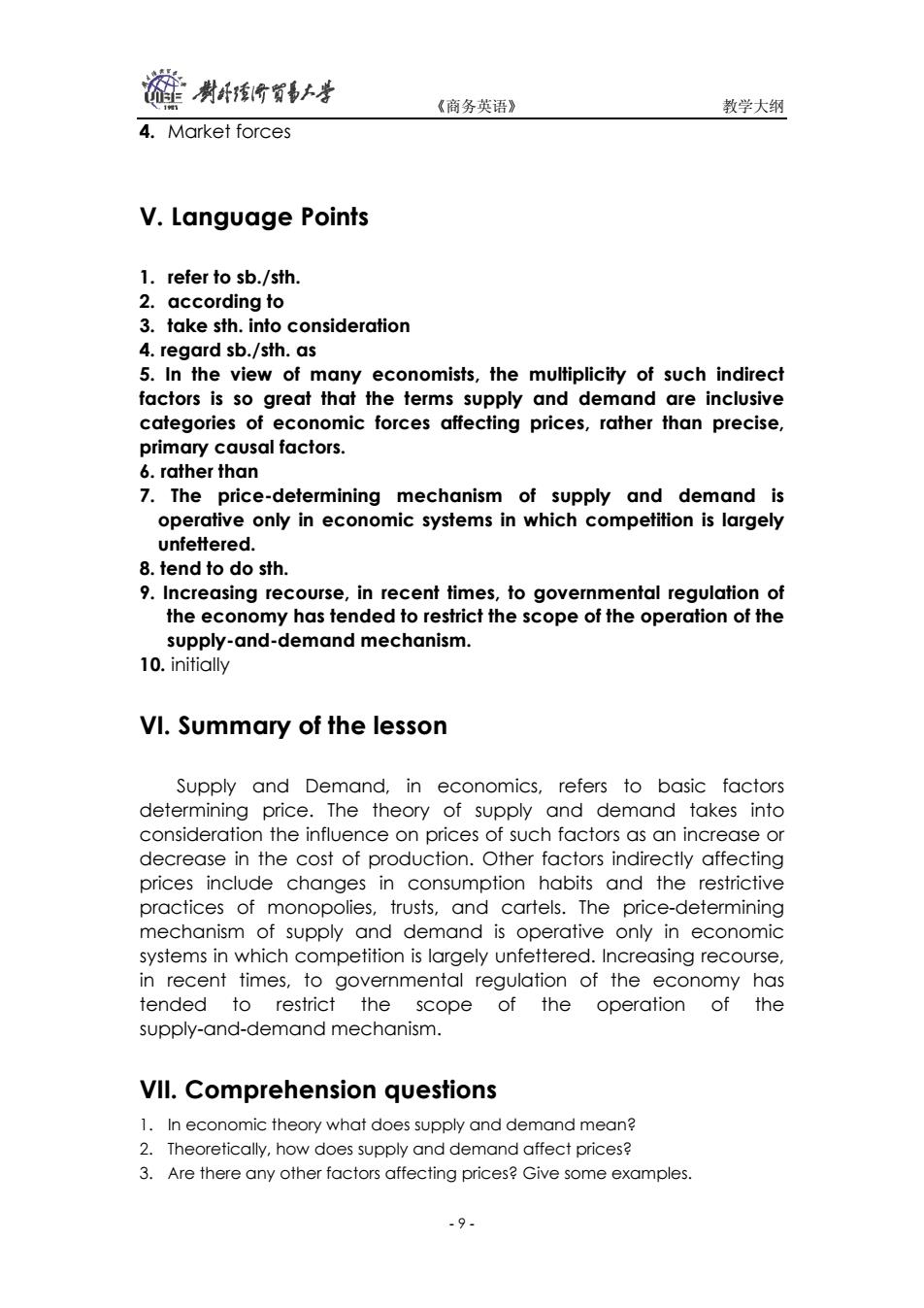
旌黄有寸 《商务英语》 教学大纲 4.Market forces V.Language Points 1.refer to sb./sth. 2.according to 3.take sth.into consideration 4.regard sb./sth.as 5.In the view of many economists,the multiplicity of such indirect factors is so great that the terms supply and demand are inclusive categories of economic forces affecting prices,rather than precise, primary causal factors. 6.rather than 7.The price-determining mechanism of supply and demand is operative only in economic systems in which competition is largely unfettered. 8.tend to do sth. 9.Increasing recourse,in recent times,to governmental regulation of the economy has tended to restrict the scope of the operation of the supply-and-demand mechanism. 10.initially VI.Summary of the lesson Supply and Demand,in economics,refers to basic factors determining price.The theory of supply and demand takes into consideration the influence on prices of such factors as an increase or decrease in the cost of production.Other factors indirectly affecting prices include changes in consumption habits and the restrictive practices of monopolies,trusts,and cartels.The price-determining mechanism of supply and demand is operative only in economic systems in which competition is largely unfettered.Increasing recourse, in recent times,to governmental regulation of the economy has tended to restrict the scope of the operation of the supply-and-demand mechanism. VIl.Comprehension questions 1.In economic theory what does supply and demand mean? 2.Theoretically,how does supply and demand affect prices? 3.Are there any other factors affecting prices?Give some examples. 9
《商务英语》 教学大纲 - 9 - 4. Market forces V. Language Points 1. refer to sb./sth. 2. according to 3. take sth. into consideration 4. regard sb./sth. as 5. In the view of many economists, the multiplicity of such indirect factors is so great that the terms supply and demand are inclusive categories of economic forces affecting prices, rather than precise, primary causal factors. 6. rather than 7. The price-determining mechanism of supply and demand is operative only in economic systems in which competition is largely unfettered. 8. tend to do sth. 9. Increasing recourse, in recent times, to governmental regulation of the economy has tended to restrict the scope of the operation of the supply-and-demand mechanism. 10. initially VI. Summary of the lesson Supply and Demand, in economics, refers to basic factors determining price. The theory of supply and demand takes into consideration the influence on prices of such factors as an increase or decrease in the cost of production. Other factors indirectly affecting prices include changes in consumption habits and the restrictive practices of monopolies, trusts, and cartels. The price-determining mechanism of supply and demand is operative only in economic systems in which competition is largely unfettered. Increasing recourse, in recent times, to governmental regulation of the economy has tended to restrict the scope of the operation of the supply-and-demand mechanism. VII. Comprehension questions 1. In economic theory what does supply and demand mean? 2. Theoretically, how does supply and demand affect prices? 3. Are there any other factors affecting prices? Give some examples
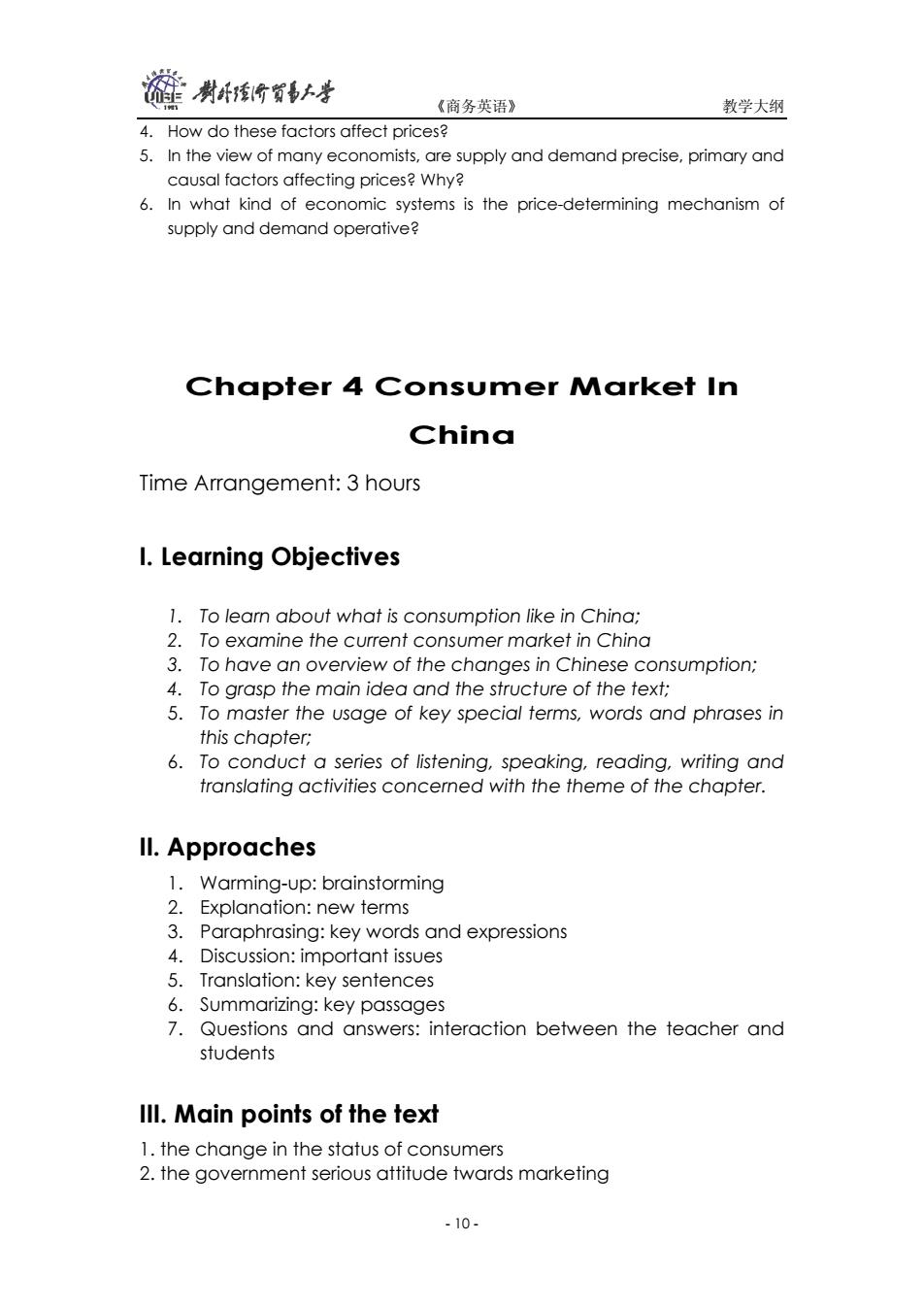
旌黄附寸 《商务英语》 教学大纲 4.How do these factors affect prices? 5.In the view of many economists,are supply and demand precise,primary and causal factors affecting prices?Why? 6.In what kind of economic systems is the price-determining mechanism of supply and demand operative? Chapter 4 Consumer Market In China Time Arrangement:3 hours I.Learning Objectives 1.To learn about what is consumption like in China; 2.To examine the current consumer market in China 3.To have an overview of the changes in Chinese consumption; 4.To grasp the main idea and the structure of the text; 5.To master the usage of key special terms,words and phrases in this chapter; 6.To conduct a series of listening,speaking,reading,writing and translating activities concerned with the theme of the chapter. ll.Approaches 1.Warming-up:brainstorming 2.Explanation:new terms 3.Paraphrasing:key words and expressions 4.Discussion:important issues 5.Translation:key sentences 6.Summarizing:key passages 7.Questions and answers:interaction between the teacher and students Ill.Main points of the text 1.the change in the status of consumers 2.the government serious attitude twards marketing -10-
《商务英语》 教学大纲 - 10 - 4. How do these factors affect prices? 5. In the view of many economists, are supply and demand precise, primary and causal factors affecting prices? Why? 6. In what kind of economic systems is the price-determining mechanism of supply and demand operative? Chapter 4 Consumer Market In China Time Arrangement: 3 hours I. Learning Objectives 1. To learn about what is consumption like in China; 2. To examine the current consumer market in China 3. To have an overview of the changes in Chinese consumption; 4. To grasp the main idea and the structure of the text; 5. To master the usage of key special terms, words and phrases in this chapter; 6. To conduct a series of listening, speaking, reading, writing and translating activities concerned with the theme of the chapter. II. Approaches 1. Warming-up: brainstorming 2. Explanation: new terms 3. Paraphrasing: key words and expressions 4. Discussion: important issues 5. Translation: key sentences 6. Summarizing: key passages 7. Questions and answers: interaction between the teacher and students III. Main points of the text 1. the change in the status of consumers 2. the government serious attitude twards marketing